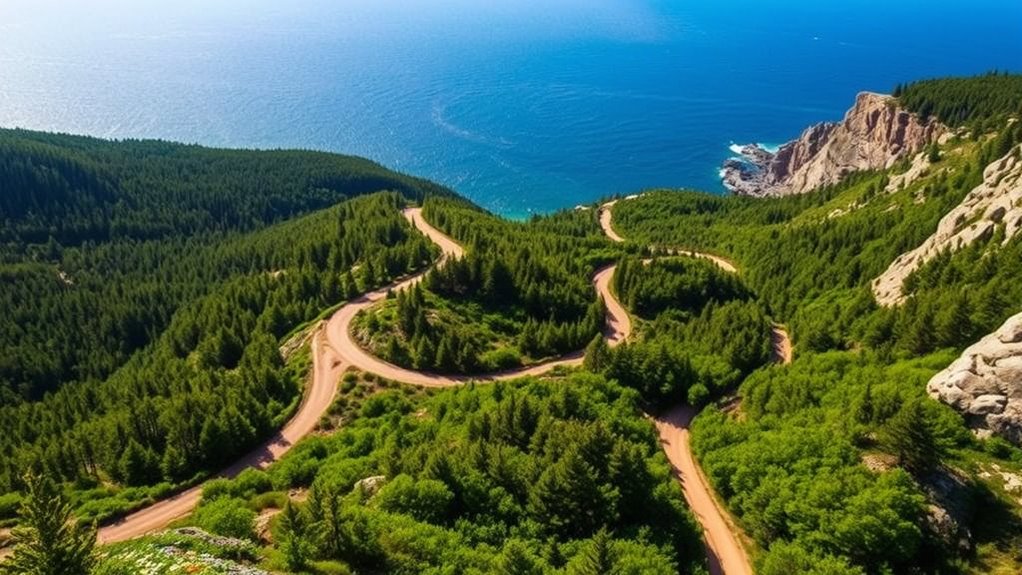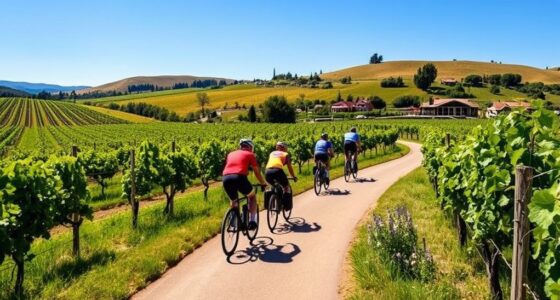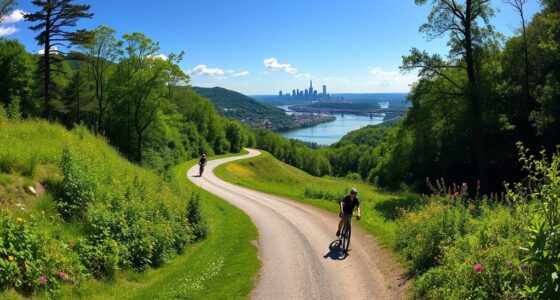When you ride Maine’s Coastal Carriage Roads, you’ll discover Acadia’s hidden treasure. Built by John D. Rockefeller Jr., these scenic pathways feature handcrafted stone bridges and smooth trails perfect for biking, hiking, and horseback riding. You’ll enjoy stunning views of lush foliage and diverse wildlife, including deer and seabirds. Whether you’re seeking leisurely carriage rides or winter adventures, there’s something for everyone. Keep exploring to uncover even more about this incredible destination!
Key Takeaways
- Acadia’s Carriage Roads offer 45 miles of scenic, motor-free paths perfect for biking, hiking, and horseback riding.
- The roads feature 17 handcrafted stone bridges and unique granite guardrails known as “Rockefeller’s Teeth.”
- Enjoy stunning autumn foliage, ideal for photography and immersive nature experiences.
- Wildlife encounters include diverse birds, White-tailed Deer, and even moose in their natural habitats.
- Community initiatives, like Take Pride in Acadia Day, help maintain these historic pathways for future generations.
The Historical Journey of Acadia’s Carriage Roads

As you explore Acadia’s Carriage Roads, you’ll discover a rich history that dates back to the early 20th century, when John D. Rockefeller Jr. purchased a summer home in Seal Harbor in 1910.
His vision for preserving scenic pathways led to the construction of these roads between 1913 and 1940. Rockefeller foresaw the rise of automobiles and wanted to maintain routes for horse-drawn carriages.
Over 25 years, he acquired land, ensuring a beautiful network. Made of broken-stone, the roads feature a unique design with native granite and stone bridges.
Recognized on the National Register of Historic Places in 1994, these roads offer a glimpse into the past while inviting you to enjoy nature free from motorized vehicles.
Scenic Features and Unique Designs
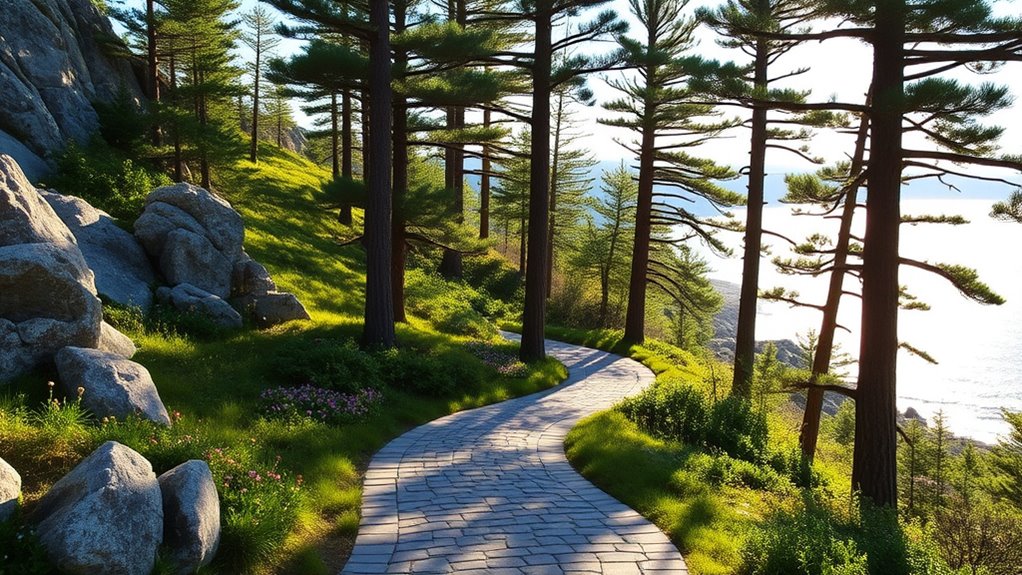
While you traverse Acadia’s Carriage Roads, you’ll be captivated by their scenic features and unique designs that enhance your outdoor experience.
The 17 handcrafted stone bridges seamlessly blend into the landscape, showcasing Rockefeller’s vision. As you ride, large granite guardrails—fondly called “Rockefeller’s Teeth”—line the paths, adding character.
Handcrafted stone bridges and iconic granite guardrails create a character-filled journey through Rockefeller’s stunning vision.
You’ll encounter serene lakes and ponds, perfect for wildlife spotting, while coastal views of the mountains and ocean unfold before you. The smooth, broken-stone surface ensures a comfortable ride, and the 16-foot wide paths accommodate everyone.
Gentle grades and natural contours offer a tranquil journey, free from motor vehicles. In autumn, vibrant fall colors transform the scenery, making it a photographer’s paradise you won’t want to miss.
Activities to Enjoy Along the Carriage Roads
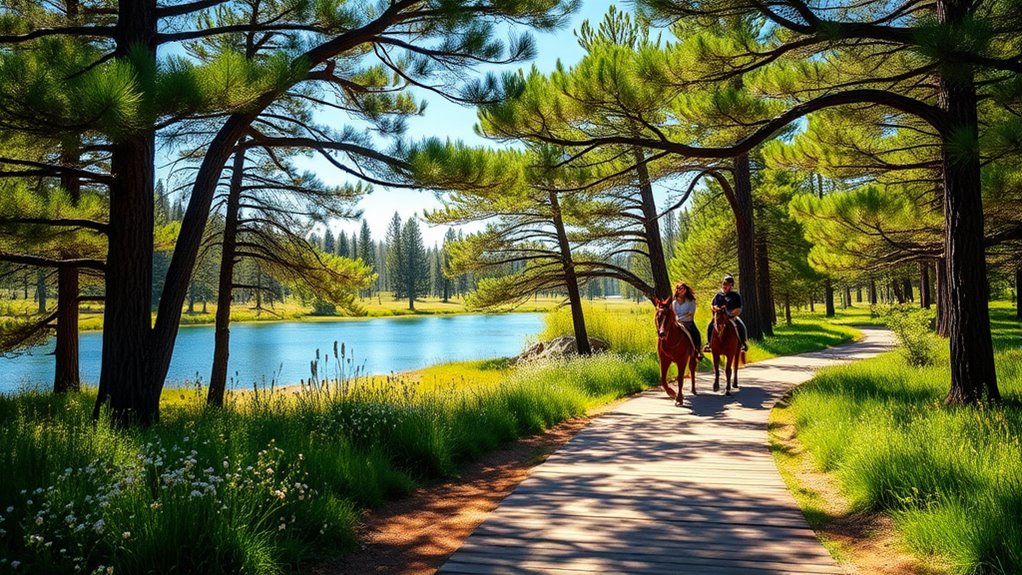
Exploring Acadia’s Carriage Roads offers a variety of activities that cater to all interests and skill levels. You can bike along the 45 miles of motor-free paths, soaking in scenic landscapes.
If hiking’s more your style, take advantage of the connecting trails to delve deeper into the park. Horseback riding provides a unique perspective, while horse-drawn carriage rides give a leisurely experience of the beautiful surroundings.
In winter, the roads transform into a haven for cross-country skiing and snowshoeing. Access points like Eagle Lake and Duck Brook Bridge make it easy to start your adventure.
With clear signage and maps, you’ll navigate the routes with ease, ensuring a memorable outdoor experience year-round.
Nature and Wildlife Encounters
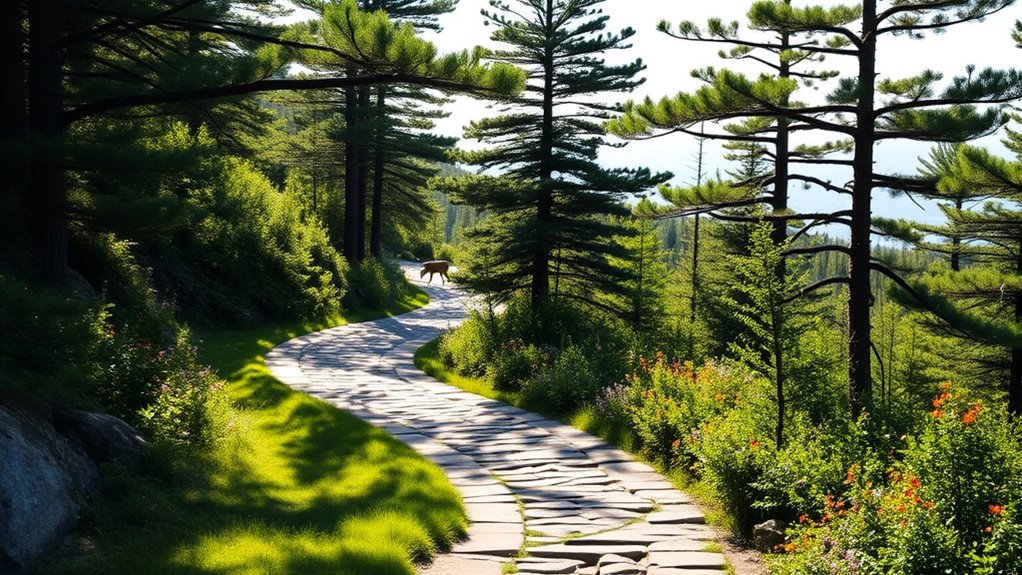
Have you ever wondered what wildlife you might encounter while wandering Acadia’s Carriage Roads? As you explore, keep an eye out for diverse bird species like the Green Heron and Wood Thrush, especially near wetland habitats like Witch Hole Pond.
The mixed forests harbor breeding songbirds, including the Black-throated Green Warbler. You may spot White-tailed Deer at sunrise or sunset along the paths. If you’re lucky, you might even catch a glimpse of a moose, though sightings are rare.
Don’t forget the coastal areas, where harbor seals lounge and seabirds like puffins nest on cliffs. Each journey along these carriage roads offers a unique opportunity to connect with Acadia’s vibrant natural world.
Seasonal Changes and Accessibility
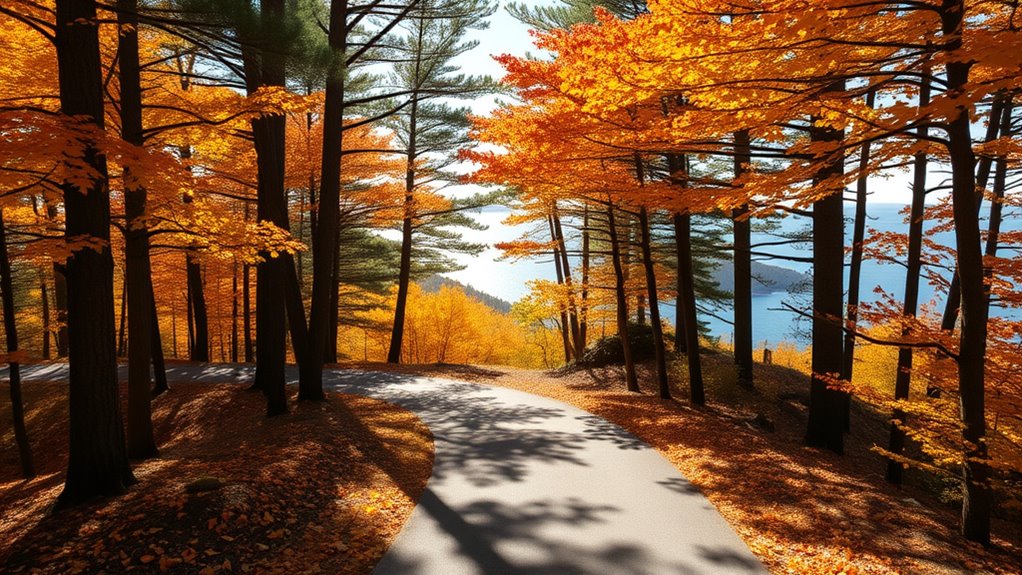
As the seasons change, Acadia’s Carriage Roads offer a dynamic experience for visitors, each period revealing its own unique charm.
During “mud season” in spring, typically starting around March 31, the roads close to protect them from damage until they dry out. Once April arrives, they reopen for walkers, bikers, and horse riders.
As spring arrives and “mud season” begins, Acadia’s Carriage Roads close to preserve their beauty until April’s reopening.
In winter, the roads transform into a serene haven for cross-country skiing and snowshoeing, although caution is needed due to snow and ice.
Autumn brings vibrant foliage, creating a picturesque backdrop for nature walks and photography.
The Island Explorer shuttle enhances accessibility in summer, allowing you to explore the scenic views and historic stone bridges without motorized distractions.
Community Support and Involvement
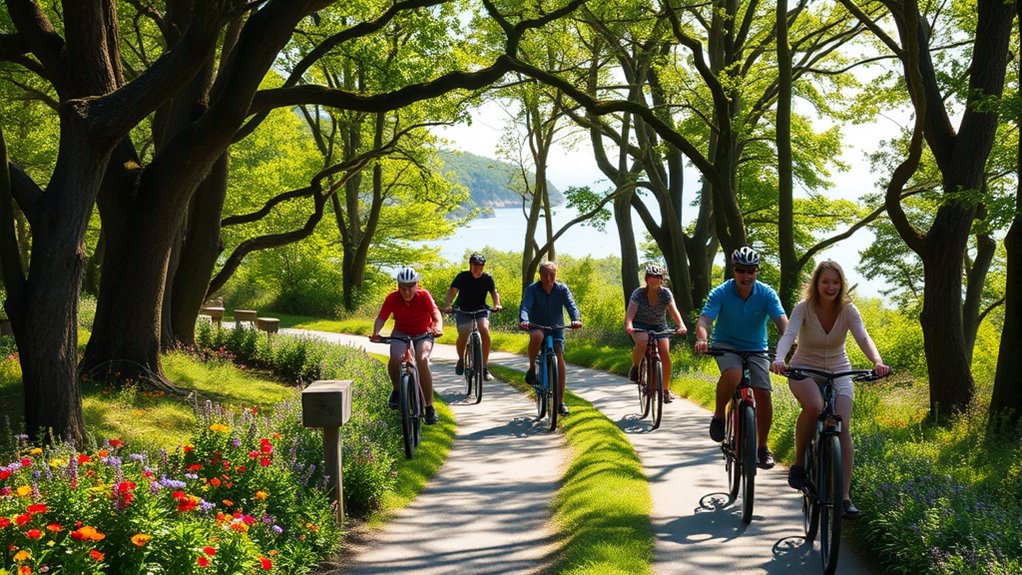
Community support plays a crucial role in maintaining and enhancing Acadia’s Coastal Carriage Roads, ensuring they remain a treasured resource for everyone.
Organizations like Friends of Acadia partner with the National Park Service to restore and preserve these historic pathways. Through fundraising efforts and volunteer initiatives, you can directly contribute to their upkeep.
Events like Take Pride in Acadia Day draw hundreds of volunteers, all working together to clear leaves and maintain the roads. Additionally, federal and private funding, including the $4 million endowment, secures long-term maintenance.
Your involvement not only helps protect these scenic routes but also fosters a sense of community, ensuring future generations can enjoy Acadia’s unique landscapes.
Join in and make a difference!
Cultural Significance of the Carriage Roads
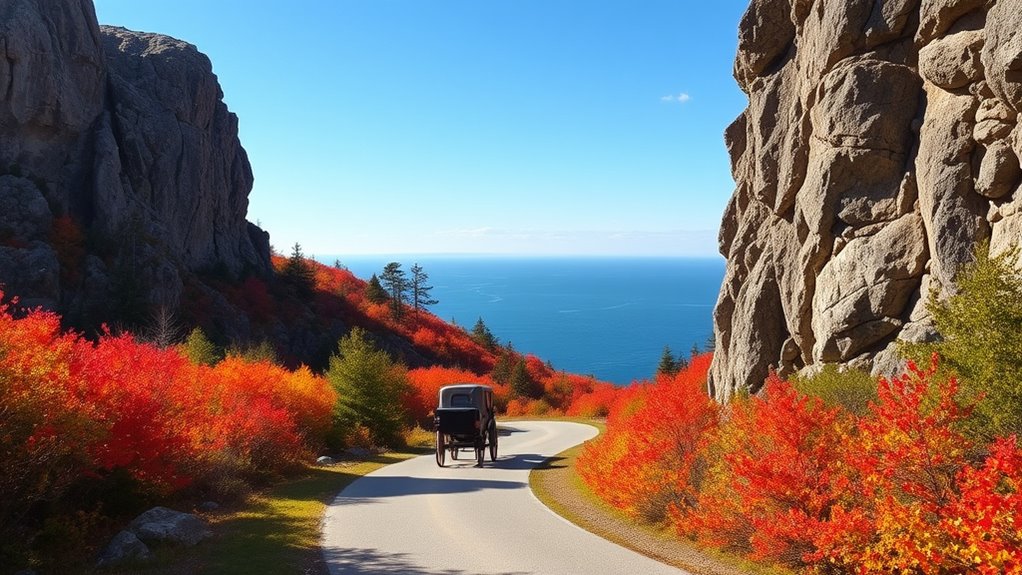
The preservation efforts surrounding Acadia’s Coastal Carriage Roads not only highlight their physical maintenance but also emphasize their deep cultural significance.
Built between 1913 and 1940 by John D. Rockefeller Jr., these roads reflect a historical commitment to preserving natural beauty while offering recreational opportunities.
The rustic design, featuring local materials and unique stone-faced bridges, showcases skilled craftsmanship and a dedication to blending with the landscape.
The rustic design and skilled craftsmanship of Acadia’s Coastal Carriage Roads beautifully blend with the surrounding landscape.
As you explore these roads, you’ll appreciate their role as historical artifacts and the philanthropic spirit behind their creation.
They support local tourism and education, allowing you to learn about early 20th-century road construction and landscape preservation techniques, all while enjoying the diverse recreational activities they offer.
Tips for Exploring Acadia’s Hidden Treasure
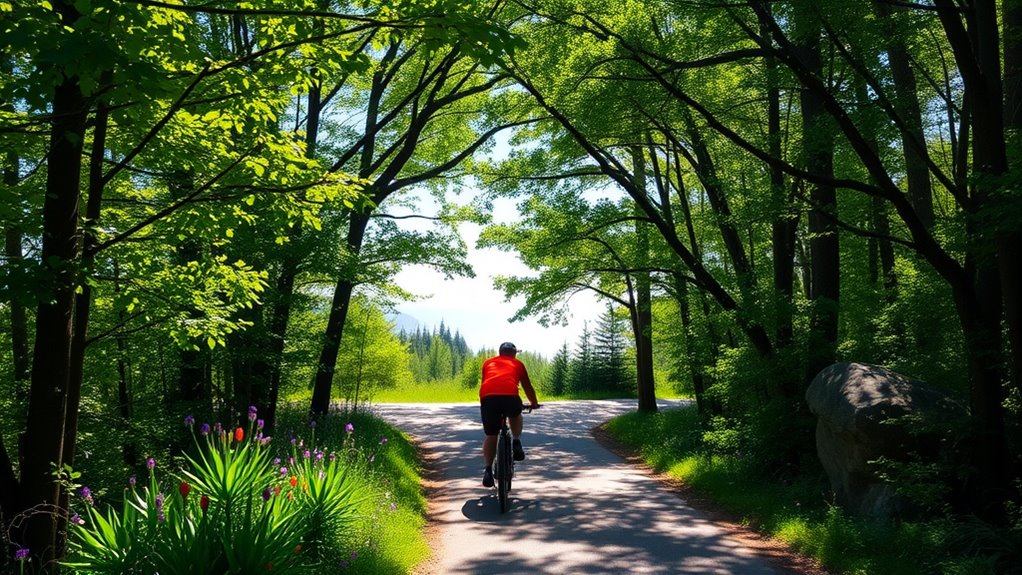
When planning your adventure on Acadia’s Coastal Carriage Roads, it’s essential to prepare for a memorable experience. Start by checking park updates for any temporary closures and plan your visit during spring or fall for the best weather and fewer crowds.
Choose from various routes, like the moderate Jordan Pond Loop or the scenic Eagle Lake Loop. If you’re biking, remember that only Class-1 e-bikes are permitted. Don’t forget your safety gear, and always yield to horses and pedestrians.
If you’re staying overnight, consider nearby hotels or campgrounds, and use the Island Explorer Bus for easy transportation. Lastly, embrace the opportunity for wildlife viewing and photography along the beautiful trails!
Frequently Asked Questions
Are There Any Fees to Access the Carriage Roads?
Yes, there are fees to access the Carriage Roads in Acadia National Park.
You’ll need a park entrance fee, which is $35 for a private vehicle, valid for seven days.
If you’re a pedestrian or cyclist, the fee is $20 for the same duration.
Don’t forget, youth under 16 can enter for free.
Make sure to check for any free entrance days if you’re planning your visit!
What Are the Best Times to Visit Acadia’s Carriage Roads?
If you’re dreaming of a picturesque escape, the best times to visit Acadia’s carriage roads are during spring and fall.
Spring brings vibrant blooms and mild weather, while fall showcases stunning foliage and fewer crowds.
Summer’s warmth attracts visitors, but be ready for bustling paths and limited parking.
Winter offers a magical quiet for cross-country skiing and snowshoeing, transforming the roads into a serene wonderland.
Each season has its charm—choose what suits you best!
Can I Bring My Dog on the Carriage Roads?
Yes, you can bring your dog on the carriage roads in Acadia National Park!
Just make sure your furry friend is leashed at all times, with a leash no longer than six feet.
You’ll need to clean up after them, too.
While you can enjoy walking, biking, or jogging together, remember that some areas, like public buildings and certain trails, aren’t pet-friendly.
Are There Restrooms Available Along the Carriage Roads?
You’d think in such a beautiful place, restrooms would be everywhere, right?
Unfortunately, that’s not the case along the carriage roads. You’ll find restrooms at key spots like Jordan Pond House and Eagle Lake, but they’re few and far between.
Port-a-potties pop up occasionally, but they’re not exactly luxurious.
So, it’s wise to plan ahead, bring a portable solution, and keep an eye on park updates for any changes.
Happy exploring!
What Type of Bike Is Best for Riding the Carriage Roads?
For riding the carriage roads, you’ll want a bike that handles gravel well. A hybrid or gravel bike is your best bet, as they offer stability and comfort.
Look for wider tires, ideally between 32 mm to 42 mm, and consider a front suspension for rough patches.
Disc brakes will give you better control, especially on varied terrain.
With the right bike, you’ll enjoy a smooth and scenic ride through beautiful landscapes.
Conclusion
As you ride along Acadia’s coastal carriage roads, you’re not just traversing a landscape; you’re weaving through a tapestry of history, nature, and community spirit. Each turn reveals breathtaking views and hidden treasures that stir the soul. So, saddle up and immerse yourself in this enchanting experience—let the gentle whispers of the wind guide you. Remember, these paths are more than just roads; they’re a bridge to the heart of Maine’s stunning beauty.
